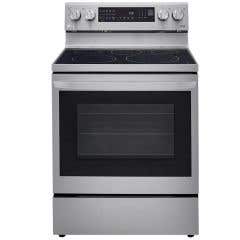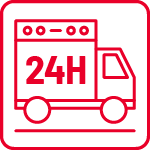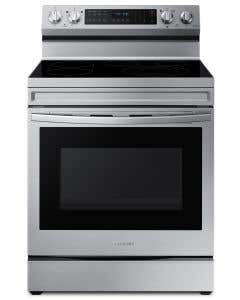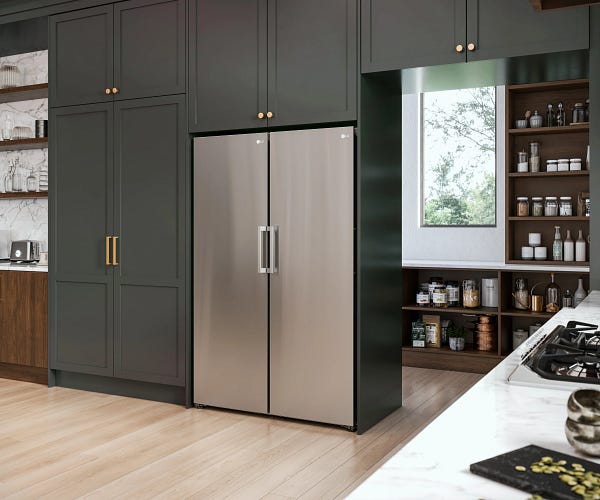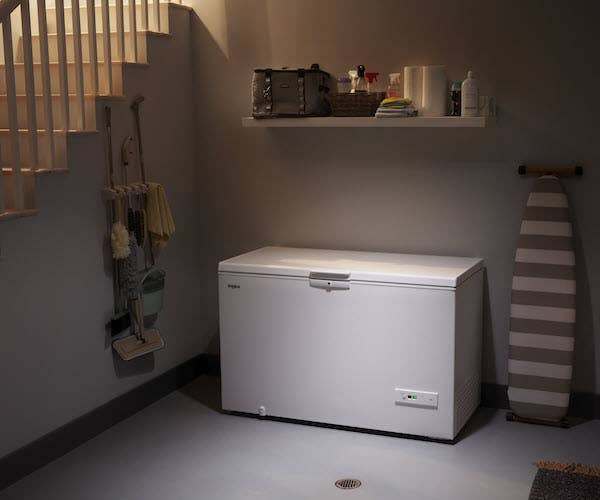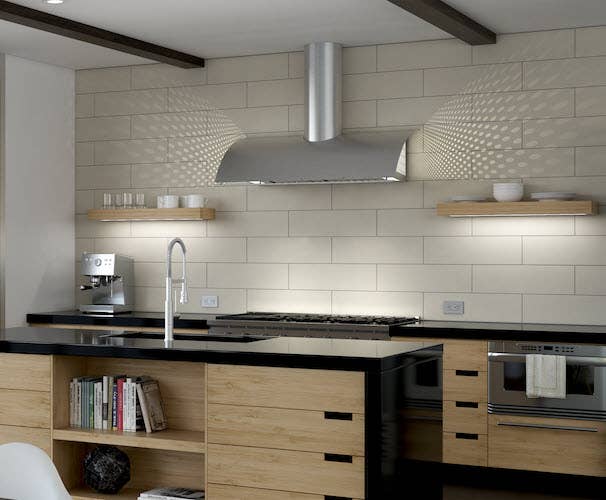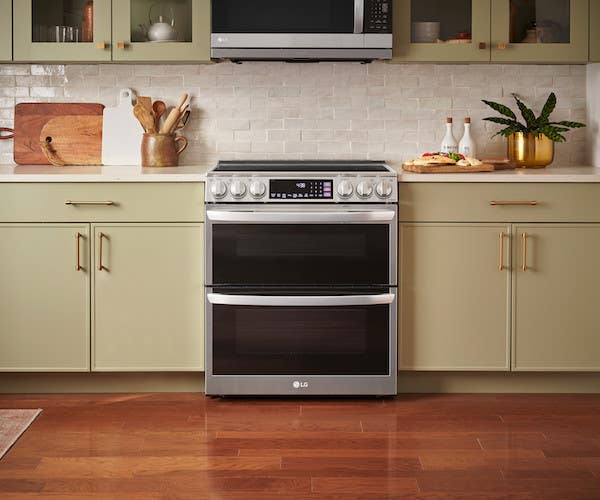Selection criteria for choosing a range
Dimensions of the range
It is important to measure the space available in your kitchen before purchasing a range, taking into account the width, depth and height of the appliance. Range sizes can vary by brand and model, so it's crucial to choose one that fits the space available and meets your cooking needs.
Generally, a range is 30 in. (76 cm) wide, but the width can vary from 20 to 35.5 in. (50 to 90 cm). The height ranges from 36 to 48 in. (91 to 122 cm) with a depth of about 25 to 27 in. (63.5 to 69 cm). Some models offer more space for large dishes and roasts, while the more compact ranges are ideal for kitchens where space is limited.
Type of range and cooktop
The free-standing range can be inserted between cabinets or at the end of a work surface since its sides are aesthetically finished. It usually has a backsplash or a rear panel. The built-in range fits completely into its environment with a more modern look. Its controls are located at the front.
With LogisVert from Hydro-Québec, get $250 off the purchase of an induction range. Learn more about this program.
Type of cooktop for the range
There are several types of ranges, each with its own advantages and disadvantages. The choice of cooktop for the range will depend on individual needs and preferences.
Coil range
The coil range, the one almost all of us grew up with, is an economical option with easily replaceable elements for a long life. However, this type of range remains limited in terms of functionality compared to other models.
Glass-ceramic range
The glass-ceramic range is affordable and easy to install and clean. It offers even cooking, but its cooking surface has a high thermal inertia, which means that the cooktop cools more slowly than other types of ranges.
Induction range
The induction range is more expensive and requires the use of compatible cookware. It is known for its excellent performance and ease of maintenance. Any food that spills on the cooktop does not cook, which makes it easier to clean.
Gas range
When choosing a gas range, consider whether you need to install a gas line to your home, if it is not already in place. The performance of the gas range is similar to that of the induction range, although popular belief often states that gas is superior. The low flame is powerful, but one of the advantages of the gas range is that it does not depend on electricity, both for the oven and the cooktop. However, its cooking surface is harder to clean.
Dual fuel range
Dual fuel ranges offer a combination of two different energy sources, usually gas for the cooktop and electricity for the oven. This combination allows users to take advantage of the benefits of each fuel type.
The gas burners provide instant heat and precise temperature control, while the electric oven distributes heat evenly and provides more precise cooking. Dual fuel ranges are often more expensive than other types of ranges, but they are popular with chefs and cooking enthusiasts who want to achieve optimal cooking results.
Some high-end models include a cooktop or grill, which is convenient for reducing the number of appliances required in the kitchen.
Oven capacity of the range
The capacity of an oven is measured in litres, between approximately 38 and 80. The size required will depend on your cooking habits and the number of people in the home.
Type of oven for the range
Once the power supply is selected (gas or electric), there are different types of ovens to choose from.
The natural convection oven, which is one of the most common, has several cooking modes. However, it takes longer to preheat.
The multi-function oven is affordable and offers more even cooking. It is equipped with different types of heat, such as fan-assisted and fan-forced.
Fan-assisted heat cooks on multiple levels thanks to additional ventilation. Fan-forced heat, on the other hand, raises the oven temperature more quickly and also allows for multi-level cooking, while being more economical.
If you choose a steam oven, you can better preserve nutrients in your food, but it is not suitable for roasting or traditional cooking. Some models also include grill, au gratin or quick sear functions.
Type of range door
Your new range may have a drop-down door, meaning that it will open downwards as in most homes. Alternatively, opt for a foldable or retractable door that hides under the oven when opened, or a side door that opens to the right or left. A drawer door conveniently allows you to bring the racks toward you rather than putting your hands in the oven.
Oven cleaning mode
Food spills are almost inevitable when cooking, so how you clean your oven is an important factor to consider when choosing an oven.
Most ovens are equipped with an automatic cleaning mode, but there are three different types: pyrolysis, catalysis and hydrolysis.
Pyrolysis uses high temperature to carbonize all residues in the oven, leaving only ash to be swept up after the cycle.
Catalysis, or EcoClean, works automatically during cooking by breaking down grease on the enamel or ceramic walls. However, this mode cannot absorb spills other than grease, so an occasional manual cleaning is required. In addition, catalysis becomes less efficient over time.
Finally, hydrolysis uses a steam bath to soften the grease stuck to the walls of the oven, making it easier to remove by hand.
As for the cooktop, the induction surface is the easiest to clean, as spilled food does not cook, followed by the glass-ceramic cooktop, which is easy to wipe clean. Coils and gas burners are more difficult to scour.
Internal layout of the range
The configuration of the range follows a traditional design with a large cavity, whose volume varies according to the dimensions, with a cooktop placed on top. If you like to cook multiple dishes simultaneously, you may want to consider a model with a double cavity or dividers, which allow you to adjust the temperature independently.
Colour and finish
When it comes to the colour and finish of your range, the key to success is choosing based on your kitchen aesthetics. The main colours available for the ranges are white, black and stainless steel, with glossy or matte finishes. The cooktop of the range is usually the same colour as the rest of the appliance, with some colour combinations for the knobs or backsplash.
Energy consumption of the range
Energy consumption is also an important factor to consider when purchasing a range.
If we look at the different types of cooktops, induction, glass-ceramic and gas cooktops consume less energy than other models to produce equivalent cooking power, in that same order. In other words, they are more economical and environmentally sustainable.
The differences in energy consumption between oven types are minimal, but pyrolysis consumes more energy than catalysis.
Other interesting features
In addition to the features listed above, additional functionality has been added to the devices to make them more convenient and attractive. For example, some ranges have a built-in retarder for smooth door closing, while others have technology that prevents the door from overheating, which is especially helpful for curious children.
The functionality of the cooktops varies according to the model. Some offer additional cooking modes such as warm, sear or simmer. Others are equipped with a built-in timer and heat indicators to prevent burn accidents. Extendable cooking zones/rings and overflow protectors also offer you more convenience and safety.
Some range models are also equipped with rails so you can easily remove racks without having to put your hands in the oven. Wi-Fi capabilities connect the unit to your phone, allowing you to receive end-of-cooking notifications, turn the range off remotely or even preheat it before you get home. A built-in temperature sensor also evaluates the temperature of your meat for optimal cooking.
To begin your search for a range, consult our specialized page or meet with one of our advisers in store.
Best Sellers


